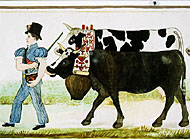Gruyère exhibition celebrates the cowbell

For nearly four centuries the most ubiquitous summer sound in the Swiss countryside has been that of the cowbell. An exhibition tracing its history has opened at the Gruyère Museum in the town of Bulle, in a region famous for its dairy cattle.
More than 200 cowbells are on display, the earliest dating back to 1620, and some which were made by local craftsmen just a few weeks ago. Over the centuries, a device enabling farmers to find their cows at night, in fog and over long distances has developed into a folk tradition which today is as popular as ever.
“The traditional processions of cows being led to their summer pastures always attract large crowds,” says museum director Denis Buchs, “and it isn’t just for the tourists.”
What they go to see – and hear – are the huge bells attached to decorated leather collars around the neck of the cows: the more beautiful the cow, the bigger the bell, but smaller ones are used during the summer grazing.
Until 1730, the collars were made of wood, and many of these can be seen in the exhibition. The bells have hardly changed since then, but the introduction of leather collars led to often highly ornate designs by the cattle owners.
Most of the cowbells in the Gruyère Museum are on loan from local families. Others are from private collections and museums – including some which were exhibited at the World Fair in Paris in 1900.
The old tradition of making cowbells with decorated collars has undergone a revival in recent years. They are made not just by craftsmen, but also by people for whom it’s a hobby,” said Buchs. “During the summer, we’ll have demonstrations of how it’s done for visitors to the exhibition.”
The exhibition ends on October 8 but one thing is certain: cowbells will continue to adorn the necks of Gruyère bovines – at least until the cows come home.
by Richard Dawson

In compliance with the JTI standards
More: SWI swissinfo.ch certified by the Journalism Trust Initiative
You can find an overview of ongoing debates with our journalists here. Please join us!
If you want to start a conversation about a topic raised in this article or want to report factual errors, email us at english@swissinfo.ch.